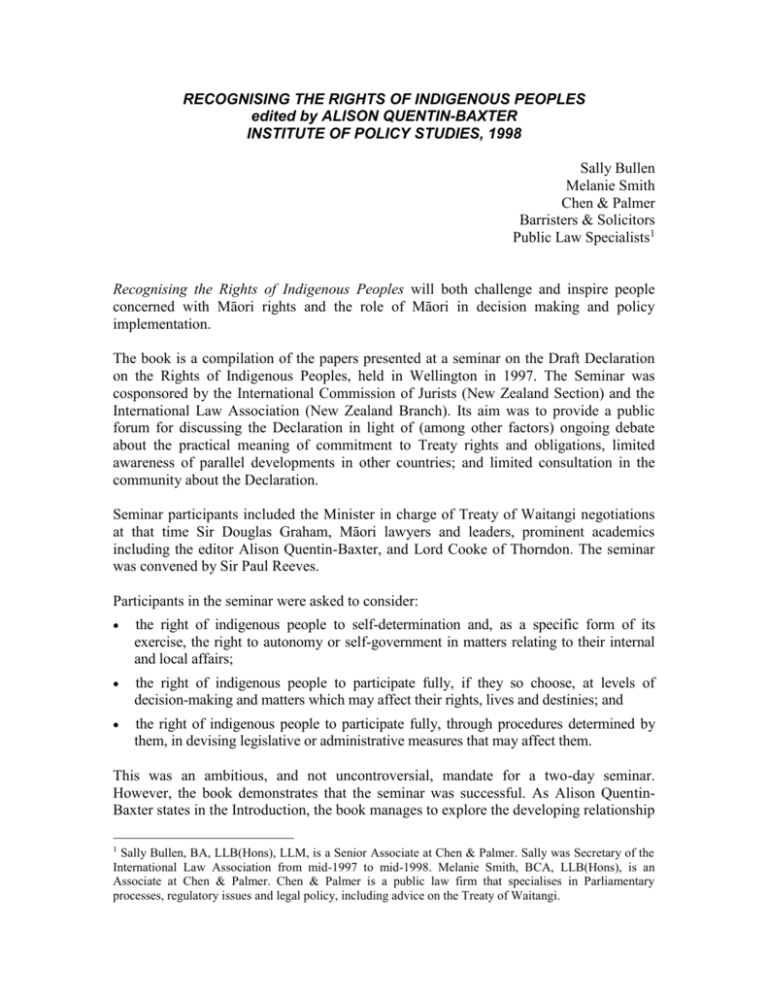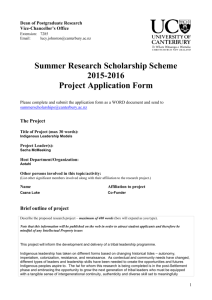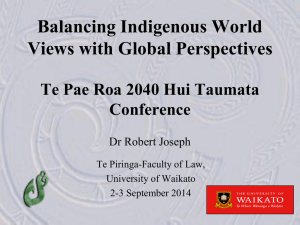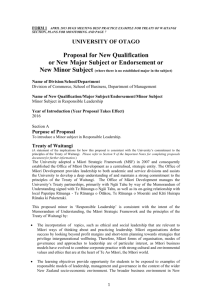the article (Word 35KB)
advertisement

RECOGNISING THE RIGHTS OF INDIGENOUS PEOPLES edited by ALISON QUENTIN-BAXTER INSTITUTE OF POLICY STUDIES, 1998 Sally Bullen Melanie Smith Chen & Palmer Barristers & Solicitors Public Law Specialists1 Recognising the Rights of Indigenous Peoples will both challenge and inspire people concerned with Māori rights and the role of Māori in decision making and policy implementation. The book is a compilation of the papers presented at a seminar on the Draft Declaration on the Rights of Indigenous Peoples, held in Wellington in 1997. The Seminar was cosponsored by the International Commission of Jurists (New Zealand Section) and the International Law Association (New Zealand Branch). Its aim was to provide a public forum for discussing the Declaration in light of (among other factors) ongoing debate about the practical meaning of commitment to Treaty rights and obligations, limited awareness of parallel developments in other countries; and limited consultation in the community about the Declaration. Seminar participants included the Minister in charge of Treaty of Waitangi negotiations at that time Sir Douglas Graham, Māori lawyers and leaders, prominent academics including the editor Alison Quentin-Baxter, and Lord Cooke of Thorndon. The seminar was convened by Sir Paul Reeves. Participants in the seminar were asked to consider: the right of indigenous people to self-determination and, as a specific form of its exercise, the right to autonomy or self-government in matters relating to their internal and local affairs; the right of indigenous people to participate fully, if they so choose, at levels of decision-making and matters which may affect their rights, lives and destinies; and the right of indigenous people to participate fully, through procedures determined by them, in devising legislative or administrative measures that may affect them. This was an ambitious, and not uncontroversial, mandate for a two-day seminar. However, the book demonstrates that the seminar was successful. As Alison QuentinBaxter states in the Introduction, the book manages to explore the developing relationship 1 Sally Bullen, BA, LLB(Hons), LLM, is a Senior Associate at Chen & Palmer. Sally was Secretary of the International Law Association from mid-1997 to mid-1998. Melanie Smith, BCA, LLB(Hons), is an Associate at Chen & Palmer. Chen & Palmer is a public law firm that specialises in Parliamentary processes, regulatory issues and legal policy, including advice on the Treaty of Waitangi. between the two main ethnic groups in New Zealand and the implications for our country's future constitutional, governmental and administrative arrangements, as well as our national culture. The authors of the papers presented in this book do not agree about the rights set out in the Draft Declaration: what they mean, whether and how they should be honoured and implemented, and their interrelationship with Treaty rights. Recognising the Rights of Indigenous Peoples is a valuable publication because it goes beyond stumbling blocks such as the question of Māori secession and the precise wording on the declaration. As the preface by Sir Paul Reeves states, the book considers the great issues of sovereignty and self-determination; and it does so with a view to moving the debate towards practical implementation of the fundamental ideals that underlie the Draft Declaration and also the Treaty of Waitangi. For the most part, the papers contain considered and thought-provoking ideas about Māori rights and constructive ways of addressing them. The book assists in finding a way forward for Pākehā/Māori relations, and provides ideas, vision, and implementation possibilities for policy makers in this area. The book is split into three parts: "The Conceptual Issues", "Implementing The Rights of Indigenous Peoples", and "The Way Forward". The text of the Draft Declaration is included as an appendix. CONCEPTUAL ISSUES EXPLORED In chapter one Sir Douglas Graham itemises the problems that the Government has with the Draft Declaration. Sir Douglas Graham was rigorously questioned, as shown by the record at the end of the chapter. These questions highlight the tension between the Māori position - that the Draft Declaration sets out minimum rights that should not be, and cannot be watered down - and the Government view that there are problems with the wording and rights in the Draft Declaration. Sir Graham argues that full self-government is not possible. Instead, the Government is willing to explore ways in which Māori can exercise greater control, within existing legal and constitutional frameworks, over issues of concern to them. He contends that the draft is too loosely and ambiguously written. For example, there is no definition in the Declaration of "indigenous people". In Sir Douglas Graham's view much work is needed to clarify the effect of the words in the Draft Declaration. Alison Quentin-Baxter's paper is the second chapter of the book, and is, in our view, one of the highlights. At the beginning of the paper, Quentin-Baxter asks some of the difficult questions that will be of concern to many Pākehā in relation to the Draft Declaration and self-determination in particular, dealing with issues of equality of law among other things. The chapter goes on to answer these questions in a well-considered and challenging manner. Alison Quentin-Baxter explains that secession from the New Zealand Government is not necessary and not required by the Draft Declaration. Alison Quentin-Baxter also looks at the relationship between international law, domestic law and the Treaty. She states that the Draft Declaration can work in practice without compromising the ideals and principles of indigenous peoples. The answer is not secession, but the need to obtain Māori agreement to national and local measures closely affecting them. This, she believes, would reconcile the exercise of kāwanatanga by the executive and rangitiratanga by Māori. She examines the granting of special rights to Māori in the context of the New Zealand constitution. She goes on to explain why the concept of equality before the law or parliamentary sovereignty is not inconsistent with the recognition of the political rights of Māori as an indigenous people. In envisaging ways forward, Quentin-Baxter borrows from the statute of Westminster and proposes as a possibility a Māori "request and consent procedure" whereby Parliament could continue to legislate for Māori in certain contexts at their request and with their consent. She also suggests the creation of a constitutional convention recognising that Parliament ought not, to make laws that are inconsistent with the Treaty, or with international law norms pertaining to the rights of indigenous people. Quentin-Baxter suggests, in limited contexts of special concern to Māori, using a manner and form provision requiring more than the approval of a majority in Parliament for certain law making, e.g. the majority of the Māori roll in a referendum. In chapters three and four, Te Atawhai Tairoa and Maui Solomon discuss the context for Māori. Te Atawhai Tairoa highlights the unique process by which the Draft Declaration was developed. In Maui Solomon's view the New Zealand Government has a moral and constitutional duty to recognise and uphold the Māori right to self-determination as recognised in the Draft Declaration, stemming from the recognition that the Treaty is the foundation of the constitutional fabric of New Zealand. Maui Solomon deals head-on with the seccession issue, acknowledging that this is a fear shared by many New Zealanders. He makes the point that there is no substantive suggestion from Māori that they desire this. Māori desire greater freedom and control over political, legal, social and domestic affairs and decision- making structures.







